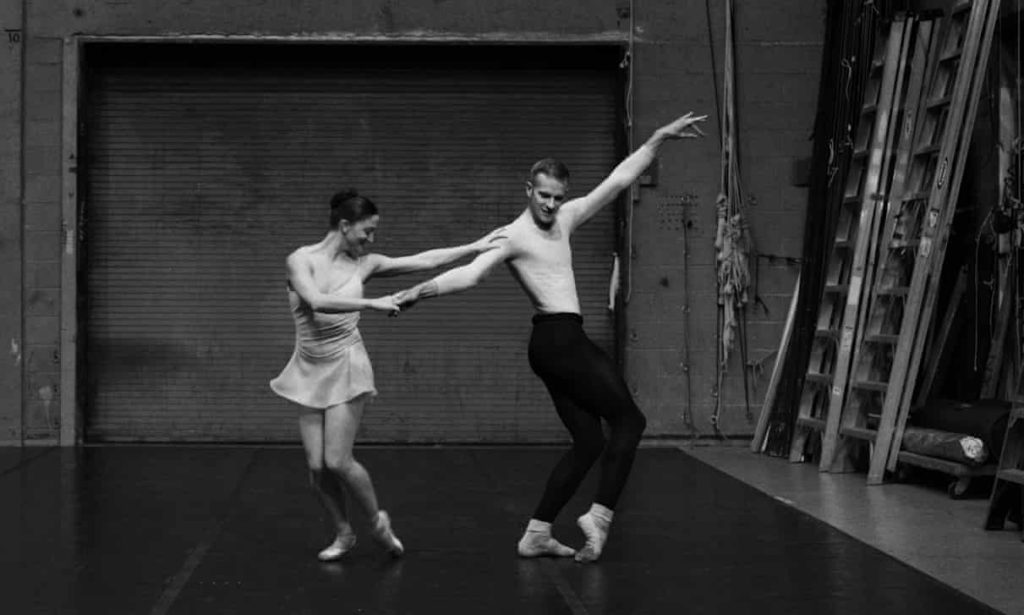VIEWPOINTS – Dancing in bold new settings: NYCB’s Digital Spring Gala & Omari Wiles’ NEW YORK IS BURNING
- By drediman
- May 9, 2021
- No Comments
As restrictive as the pandemic has been for much of the performing arts, it has also necessitated that artists consider fascinating new possibilities. For example, during the past year, choreographers and dancers who continued to pursue their art have had to boldly create stages of their own, thereby freeing them from the confines of invariably bare, rectangular surfaces and encouraging them to share the “spotlight” with their chosen environment (e.g., museums, homes, public spaces, the natural world, etc.). Whether these performances were streamed or, more recently, safely presented in-person, these symbiotic performances have embraced dance as an environmentally reactive medium, and not just a social/solo one. This week, I encountered two programs that continued this ongoing dialogue between bodies in motion and their immediate surroundings. Here are my thoughts.

DIGITAL SPRING GALA
New York City Ballet
On-demand through May 20
New York City Ballet scored a big artistic success with its last digital production, Kyle Abraham’s chilly but exquisite When We Fell. That work pushed the ballet company to sublimely engage with their monumental Lincoln Center home in a way that seemed to shake the the city’s marquee dance company from the timidity and relative stasis that had characterized its performance output for much of the pandemic. For its Digital Spring Gala (RECOMMENDED), City Ballet has chosen to employ the same hybrid film/dance approach, this time tapping acclaimed filmmaker Sofia Coppola to direct. The 30-minute film, shot mostly in austere black-and-white and featuring excerpts from the company’s expansive repertory, artfully captures the progression from rehearsal studio (Gonzalo Garcia casually wandering into Robbins’ “Dances at a Gathering”), to waiting in the wings (Ashley Bouder and Russell Janzen, charming in Balanchine’s “Duo Concertant”), to pre-performance anticipation in the plaza/lobby (Maria Kowroski and Ask la Cour elegantly floating through Balanchine’s “Liebeslieder Walzer”), and finally to the full bloom of performance (Balanchine’s “Divertimento No. 15”, in vibrant color, as led by the impeccable Tiler Peck). Seeing these familiar dances in new, more intimate environs invited me to assess them afresh – an alluring prospect. Set to the emotive strings of Samuel Barber’s “Adagio”, the evening’s new work was Justin Peck’s “Solo” – an obvious reference to pandemic-induced isolation – and it was danced with unadorned beauty by Anthony Huxley. Throughout, there were definite hints of the company’s vulnerability as it continues to stride back towards full performance, making this document all the more human and touching.

NEW YORK IS BURNING
Les Ballet Afrik / Works & Processh / Guggenheim Museum
In-person on May 4
As the city’s performing arts scenes commenced its re-awakening over the past month, the Guggenheim’s Works & Process series has been at the forefront of presenting in-person performances – not only in terms of frequency, but also accessibility (via a healthy lineup of free daytime pop-up performances) and diversity/inclusion. Last week saw the museum’s iconic rotunda host New York Is Burning (RECOMMENDED), Omari Wiles’ homage to Paris Is Burning, the landmark 1990 documentary portraying the underground ballroom culture during the height of the AIDS crisis. The present seems the right time to revive the defiant sentiments of the seminal film, given the parallels between now and then. Indeed, in the 30-minute New York Is Burning, Mr. Wiles has created a work that’s an unabashed celebration in the face of the terrible woes of the past year. As ecstatically danced by Les Ballet Afrik, the piece is a loose but fluid patchwork that’s punctuated with bursts of uninhibited exuberance. In the tradition of ballroom, the piece fuses African dance, Afrobeat, house, and vogue – while infusing it all with a thrilling urgency and authentic sense community that feels utterly of the moment. This is dance as survival tactic. It was also refreshing to see represented an eclectic array of body types, as well as idiosyncratic interpretations of movement – which is in exciting contrast to the buttoned-up precision, uniformity, and synchronicity of City Ballet. Performed in one of the meccas of high brow culture, Mr. Wiles and his New York Is Burning has proven that ballroom culture need not be nor should be relegated to the rowdy, out-of-sight underground clubs of its origins.

 Copyright © 2024
Copyright © 2024
Leave a Reply